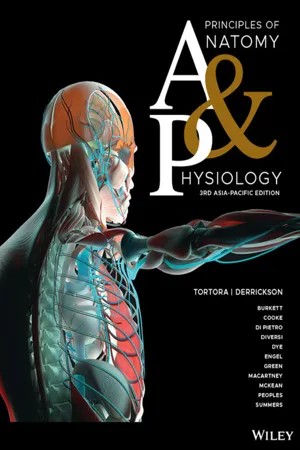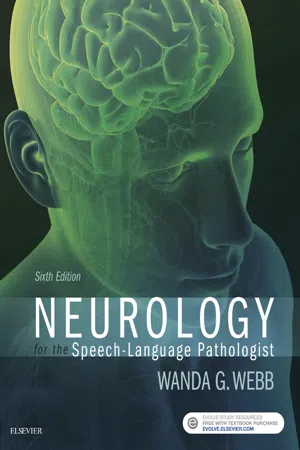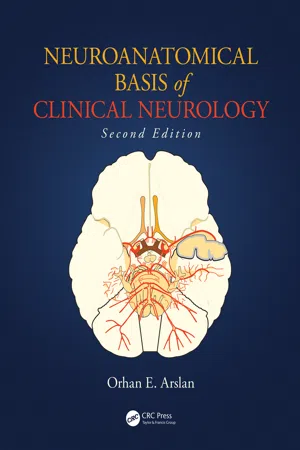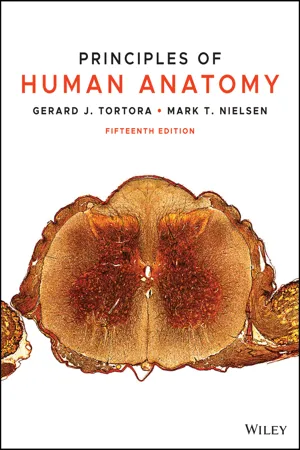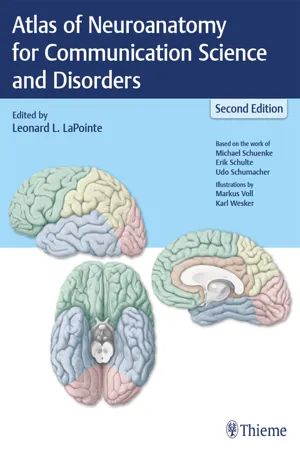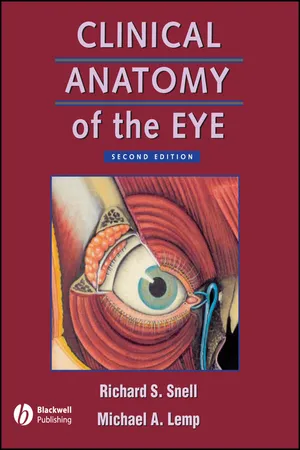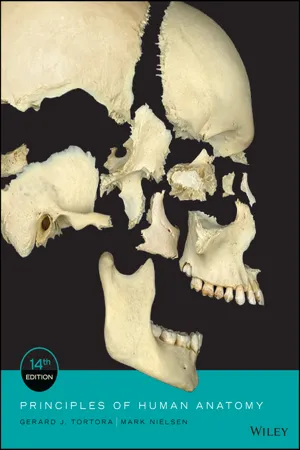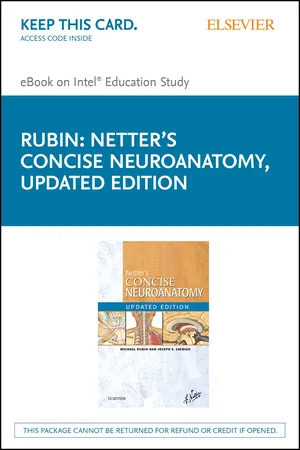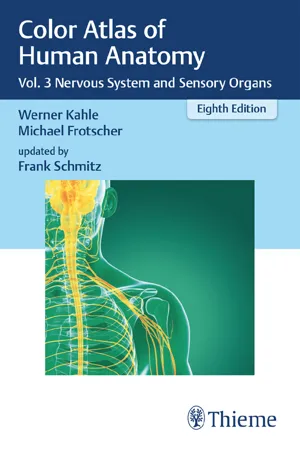Biological Sciences
Cranial Nerves
Cranial nerves are a set of 12 pairs of nerves that emerge directly from the brain and brainstem. They are responsible for controlling various functions such as sensation, movement, and autonomic activities in the head and neck. Each cranial nerve has specific functions and innervates specific areas, playing a crucial role in the overall functioning of the nervous system.
Written by Perlego with AI-assistance
Related key terms
1 of 5
12 Key excerpts on "Cranial Nerves"
- Gerard J. Tortora, Bryan H. Derrickson, Brendan Burkett, Gregory Peoples, Danielle Dye, Julie Cooke, Tara Diversi, Mark McKean, Simon Summers, Flavia Di Pietro, Alex Engel, Michael Macartney, Hayley Green(Authors)
- 2021(Publication Date)
- Wiley(Publisher)
The 12 pairs of Cranial Nerves are so named because they pass through various foramina in the bones of the cranium and arise from the brain inside the cranial cavity. Like the 31 pairs of spinal nerves, they are part of the peripheral nervous system (PNS). Each cranial nerve has both a number, designated by a roman numeral, and a name. The numbers indicate the order, from anterior to posterior, in which the nerves arise from the brain. The names designate a nerve’s distribution or function. Three Cranial Nerves (I, II, and VIII) carry axons of sensory neurons and thus are called special sensory nerves. These nerves are unique to the head and are associated with the special senses of smelling, seeing, and hearing. The cell bodies of most sensory neurons are located in ganglia outside the brain. Five Cranial Nerves (III, IV, VI, XI, and XII) are classified as motor nerves because they contain only axons of motor neurons as they leave the brain stem. The cell bodies of motor neurons lie in nuclei within the brain. Motor axons that innervate skeletal muscles are of two types. 1. Branchial motor axons innervate skeletal muscles that develop from the pharyngeal (branchial) arches (see figure 14.28). These neurons leave the brain through the mixed Cranial Nerves and the accessory nerve. 2. Somatic motor axons innervate skeletal muscles that develop from head somites (eye muscles and tongue muscles). These neurons exit the brain through five motor Cranial Nerves (III, IV, VI, XI, and XII). Motor axons that innervate smooth muscle, cardiac muscle, and glands are called autonomic motor axons and are part of the parasympathetic division. The remaining four Cranial Nerves (V, VII, IX, and X) are mixed nerves — they contain axons of both sensory neurons entering the brain stem and motor neurons leaving the brain stem. Each cranial nerve is covered in detail in exhibits 14.A through 14.J.- eBook - ePub
Neurology for the Speech-Language Pathologist - E-Book
Neurology for the Speech-Language Pathologist - E-Book
- Wanda Webb, Richard K. Adler(Authors)
- 2016(Publication Date)
- Mosby(Publisher)
7The Cranial Nerves
To those I address, it is unnecessary to go further than to indicate that the nerves treated in these papers are the instruments of expression from the smile of the infant’s cheek to the last agony of life.Charles Bell, 1824Chapter OutlineOrigin of the Cranial Nerves Names and Numbers Embryologic Origin The Corticonuclear Tract and the Cranial Nerves Cranial Nerves for Smell and Vision Cranial Nerves for Speech and Hearing Cranial Nerve V: Trigeminal Cranial Nerve VII: Facial Cranial Nerve VIII: Acoustic-Vestibular or Vestibulocochlear Cranial Nerve IX: Glossopharyngeal Cranial Nerve X: Vagus Cranial Nerve XI: Spinal Accessory Cranial Nerve XII: Hypoglossal Instrumental Measurement of Strength Cranial Nerve Cooperation: The Act of Swallowing Assessment of SwallowingKey Termsabducens abduction branchial central pattern generator chorda tympani Cranial Nerves diplopia flaccid genioglossus glottal coup hyoglossus internuncial lacrimal palpate primary olfactory cortex ptosis secretomotor solely special sensory styloglossus tinnitusThis chapter is intended to help the speech-language pathologist (SLP) understand one of the most important components of the nervous system in regard to the acts of hearing, speaking and swallowing. The Cranial Nerves comprise a part of the peripheral nervous system that provides crucial sensory and motor information for the oral, pharyngeal, and laryngeal musculature and the auditory and vestibular systems. The speech-language pathologist should be familiar with the names, structure, innervation, testing procedures, and signs of abnormal function of the Cranial Nerves. This information is especially critical when working with an adult or child with dysarthria and/or dysphagia.Origin of the Cranial Nerves
Names and Numbers
Twelve pairs of Cranial Nerves leave the brain and pass through the foramina of the skull. They are referred to by their numbers, written in Roman numerals, and by their names. The names sometimes give a clue to the function of the nerves, but the number, name, and concise descriptions of the various functions should all be learned (Table 7-1 ). Many students use a suggested mnemonic device to help them remember the Cranial Nerves (e.g., “O n O ld O lympus’ T owering T op A F inn A nd G erman V end A t H - eBook - PDF
- Orhan E. Arslan(Author)
- 2014(Publication Date)
- CRC Press(Publisher)
267 The Cranial Nerves, as the name implies, lie within the cra-nial fossae, some may travel in the head, neck, while oth-ers continue their paths through the thoracic and abdominal cavities, innervating structures in these areas. They are clas-sified according to their functional components and connec-tions into purely sensory nerves (e.g., olfactory and optic); motor nerves (e.g., oculomotor, trochlear, abducens, acces-sory, and hypoglossal); and mixed nerves, containing both sensory and motor components (e.g., trigeminal, facial, glos-sopharyngeal, and vagus). The axons of the bipolar neurons in the olfactory mucosa form the olfactory nerve, while that of the Scarpa’s and spiral ganglia form vestibulocochlear nerve. In the same manner the axons of the multipolar neu-rons of the retina make the optic nerve. Due to its origin from the retina, a telencephalic structure, the optic nerve, is con-sidered as an extension of the central nervous system and is affected by central demyelinating diseases. The general and special sensory fibers are the central processes of the unipo-lar neurons of the geniculate ganglion of the facial nerve, and the bipolar neurons of the superior and inferior ganglia of the glossopharyngeal and vagus nerves. The motor fibers within the Cranial Nerves represent the axons of the multipolar neu-rons. A lesion of a cranial nerve or associated nucleus pro-duces manifestations of lower motor neuron palsy: atrophy, flaccidity, and areflexia or hyporeflexia with the exception of the abducens nerve and nucleus. Affected structures usually deviate to the side of the lesion, with the exception a lesion of the vagus nerve, which produces deviation toward the intact side. Cranial nerve motor nuclei receive evenly distributed bilateral corticobulbar fibers with the exception of the facial motor neurons to the upper face which receives bilateral cortical input compared to neurons of the lower face which receive only contralateral cortical input. - eBook - ePub
- Russell J. Love, Wanda G. Webb(Authors)
- 2013(Publication Date)
- Butterworth-Heinemann(Publisher)
7The Cranial Nerves
Publisher Summary
This chapter highlights the parts of the nervous system involved in the act of speaking. The Cranial Nerves make up a part of the peripheral nervous system that provides crucial sensory and motor information to the oral musculature. The Cranial Nerves are vital for speech production, and the speech-language pathologist must be knowledgeable about their functions. There are 12 pairs of Cranial Nerves and 6 of them are directly related to speech production—Cranial Nerves V (trigeminal), VII (facial), VIII (acoustic-vestibular), IX (glossopharyngeal), X (vagus), and XII (hypoglossal). This chapter refers to the embryologic origin of the Cranial Nerves, explaining those which are somatic or branchial in origin and those which are solely special sensory nerves. The chapter also discusses the anatomy, innervation, function, and testing of each of the nerves associated with speech. It describes the cooperation of several Cranial Nerves in the act of swallowing.“—Charles Bell, 1824To those I address, it is unnecessary to go further than to indicate that the nerves treated in these papers are the instruments of expression from the smile of the infant’s cheek to the last agony of life …”Introduction
This chapter is intended to help the speech-language pathologist understand one of the most important parts of the nervous system with respect to the act of speaking. The Cranial Nerves make up a part of the peripheral nervous system that provides crucial sensory and motor information to the oral musculature. The speech-language pathologist should be very familiar with the names, structure, innervation, testing procedure, and signs of abnormal function of the Cranial Nerves. This information will be vital in working with the dysarthric adult and child.Names and Number
Twelve pairs of Cranial Nerves leave the brain and pass through the foramina of the skull. They are known both by their numbers, written in Roman numerals, and by their names. The names sometimes give a clue to the function of the nerve, but it is best to learn the number, the name, and a concise description of the various functions. Such a description is found in Table 7-1 . Many students use a mnemonic device to help them remember the Cranial Nerves—for example, O n O ld O lympus’ T owering T op A F inn A nd G erman V end A t H - eBook - PDF
- Gerard J. Tortora, Mark Nielsen(Authors)
- 2020(Publication Date)
- Wiley(Publisher)
Like the 31 pairs of spinal nerves, they are part of the peripheral nervous system (PNS). Each cranial nerve has both a number, designated by a roman numeral, and a name (Figure 18.17). The numbers indicate the order, from cranial to caudal, in which the nerves arise from the brain. The names designate a nerve’s distribution, structure, or function. Three Cranial Nerves (I, II, and VIII) carry axons of sensory neurons into the brain and thus are called special sensory nerves. These nerves are unique to the head and are associ- ated with the special senses of smelling, seeing, and hearing. The cell bodies of most sensory neurons are located in ganglia outside the brain. (One exception is the proprioceptive cell bod- ies of the mesencephalic nucleus of the trigeminal (V) nerve, which has pseudounipolar cell bodies typical of a sensory gan- glion, but is located in the central nervous system, classifying it as a nucleus and not a ganglion.) Four Cranial Nerves (III, IV, VI, and XII) are classified as motor nerves because they contain only axons of motor neurons as they leave the brainstem. The cell bodies of motor neurons lie in nuclei within the brain. Motor axons that innervate skeletal muscles are of three types: 1. Pharyngeal (branchial) motor axons innervate skeletal muscles that develop from the pharyngeal (branchial) arches (see Figure 4.13). These neurons leave the brain through the mixed Cranial Nerves. 2. Somatic motor axons innervate skeletal muscles that develop from prechordal mesoderm (extrinsic eye mus- cles) and occipital somites (tongue muscles). These neu- rons exit the brain through four motor Cranial Nerves (III, IV, VI, and XII). 3. Lateral mesoderm motor axons (XI), which actually arise from the cervical spinal cord and innervate the trapezius and sternocleidomastoid muscles. Motor axons that innervate smooth muscle, cardiac muscle, and glands are called autonomic motor axons and are part of the parasympathetic part of the autonomic division. - Leonard L. LaPointe(Author)
- 2018(Publication Date)
- Thieme(Publisher)
112 5.1 Overview of the Cranial Nerves 5.1.1 Functional Components of the Cranial Nerves The twelve pairs of Cranial Nerves are designated by Roman nu-merals according to the order of their emergence from the brain-stem (see topographical organization in Chapter 5.1.3). Note: The first two Cranial Nerves, the olfactory nerve (CN I) and optic nerve (CN II), are not peripheral nerves in the true sense rather extensions of the brain, that is, they are central nervous system (CNS) pathways that are covered by meninges and contain cell types occurring exclusively in the CNS (oligodendrocytes and microglial cells). Like the spinal nerves, the Cranial Nerves may contain both afferent and efferent axons. These axons belong either to the so-matic nervous system, which enables the organism to interact with its environment (somatic fibers) , or to the autonomic ner-vous system, which regulates the activity of the internal organs (visceral fibers) . The combinations of these different general fiber types in spinal nerves result in four possible compositions that are found chiefly in spinal nerves but also occur in Cranial Nerves (see functional organization in Chapter 5.1.3). 5.1.2 Color Coding Used in Subsequent Units to Indicate Different Fiber Types See Fig. 5.1 . 5 Cranial Nerves General somatic afferents (somatic sensation): • Fibers convey impulses from the skin and striated muscle spindles General visceral afferents (visceral sensation): • Fibers convey impulses from the viscera and blood vessels General visceral efferents (visceromotor function): • Fibers innervate the smooth muscle of the viscera, intraocular muscles, heart, salivary glands, etc.- eBook - ePub
- Richard S. Snell, Michael A. Lemp(Authors)
- 2013(Publication Date)
- Wiley-Blackwell(Publisher)
The Cranial Nerves described in this chapter are the olfactory, facial, vestibulocochlear, glossopharyngeal, vagus, accessory, and hypoglossal nerves. The olfactory and vestibulocochlear nerves are entirely sensory in function. The accessory and hypoglossal nerves are entirely motor in function. The facial, glossopharyngeal, and vagus nerves are both motor and sensory. Because these nerves are not directly associated with the eye and orbit, only a brief account of each nerve is given here. The different components of the Cranial Nerves, their functions, and the openings in the skull through which the nerves leave the cranial cavity are summarized in Table 10-2.The Sensory Nerves
Olfactory Nerves (Cranial Nerve I)
The olfactory nerves are responsible for conducting the sensations of smell from the upper part of the nasal mucous membrane to the olfactory bulbs in the skull.Origin and Course
The olfactory nerves arise from the olfactory receptor nerve cells in the olfactory mucous membrane located in the upper part of the nasal cavity above the level of the superior concha (Fig. 11-1 ). The olfactory receptor cells are scattered among supporting cells. Each receptor cell consists of a small bipolar nerve cell with a coarse peripheral process that passes to the surface of the membrane and a fine central process. From the coarse peripheral process a number of short cilia, the olfactory hairs, arise and project into the mucus covering the surface of the mucous membrane. These projecting hairs react to odors in the air and stimulate the olfactory cells.The fine central processes form the olfactory nerve fibers (Fig. 11-1 ). Bundles of these nerve fibers pass through the openings of the cribriform plate of the ethmoid bone to enter the olfactory bulb inside the skull.Central Connections
Olfactory Bulbs
This ovoid structure lies in the anterior cranial fossa and possesses several types of nerve cells including the large mitral cell (Fig. 11-1 - eBook - PDF
- Gerard J. Tortora, Bryan H. Derrickson(Authors)
- 2020(Publication Date)
- Wiley(Publisher)
14.19 Development of the Nervous System 537 TABLE 14.4 Summary of Cranial Nerves* Cranial Nerve Components Principal Functions Olfactory (I) Special sensory Olfaction (smell). Optic (II) Special sensory Vision (sight). Oculomotor (III) Motor Somatic Motor (autonomic) Movement of eyeballs and upper eyelid. Adjusts lens for near vision (accommodation). Constriction of pupil. Trochlear (IV) Motor Somatic Movement of eyeballs. Trigeminal (V) Mixed Sensory Motor (branchial) Touch, pain, and thermal sensations from scalp, face, and oral cavity (including teeth and anterior two-thirds of tongue). Chewing and controls middle ear muscle. Abducens (VI) Motor Somatic Movement of eyeballs. Facial (VII) Mixed Sensory Motor (branchial) Motor (autonomic) Taste from anterior two-thirds of tongue. Touch, pain, and thermal sensations from skin in external acoustic meatus. Control of muscles of facial expression and middle ear muscle. Secretion of tears and saliva. Vestibulocochlear (VIII) Special sensory Hearing and equilibrium. Glossopharyngeal (IX) Mixed Sensory Motor (branchial) Motor (autonomic) Taste from posterior one-third of tongue. Proprioception in some swallowing muscles. Monitors blood pressure and oxygen and carbon dioxide levels in blood. Touch, pain, and thermal sensations from skin of external ear and upper pharynx. Assists in swallowing. Secretion of saliva. Vagus (X) Mixed Sensory Motor (branchial) Motor (autonomic) Taste from epiglottis. Proprioception from throat and voice box muscles. Monitors blood pressure and oxygen and carbon dioxide levels in blood. Touch, pain, and thermal sensations from skin of external ear. Sensations from thoracic and abdominal organs. Swallowing, vocalization, and coughing. Motility and secretion of digestive canal organs. Constriction of respiratory passageways. Decreases heart rate. Accessory (XI) Motor Branchial Movement of head and pectoral girdle. Hypoglossal (XII) Motor Somatic Speech, manipulation of food, and swallowing. - eBook - PDF
- Gerard J. Tortora, Mark Nielsen(Authors)
- 2016(Publication Date)
- Wiley(Publisher)
Receives somatic sensory signals from and controls muscles on right side of body Reasoning Numerical and scientific skills Ability to use and understand sign language Spoken and written language Persons with damage in the left hemisphere often exhibit aphasia. RIGHT HEMISPHERE Anterior view LEFT HEMISPHERE 618 CHAPTER 18 • THE BRAIN AND THE Cranial Nerves order, from cranial to caudal, in which the nerves arise from the brain. The names designate a nerve’s distribution or function. Three Cranial Nerves (I, II, and VIII) carry axons of sensory neu- rons into the brain and thus are called special sensory nerves. These nerves are unique to the head and are associated with the special senses of smelling, seeing, and hearing. The cell bodies of most sensory neurons are located in ganglia outside the brain. (One exception is the proprioceptive cell bodies of the mesencephalic nucleus of the trigeminal (V) nerve, which has pseudounipolar cell bodies typical of a sensory ganglion, but is located in the central nervous system, classifying it as a nucleus and not a ganglion.) Four Cranial Nerves (III, IV, VI, and XII) are classified as mo- tor nerves because they contain only axons of motor neurons as they leave the brainstem. The cell bodies of motor neurons lie in nuclei within the brain. Motor axons that innervate skeletal muscles are of three types: 1. Branchial motor axons innervate skeletal muscles that develop from the pharyngeal (branchial) arches (see Figure 4.13). These neurons leave the brain through the mixed Cranial Nerves. 2. Somatic motor axons innervate skeletal muscles that develop from prechordal mesoderm (extrinsic eye muscles) and occipi- tal somites (tongue muscles). These neurons exit the brain through four motor Cranial Nerves (III, IV, VI, and XII). 3. Lateral mesoderm motor axons (XI), which actually arise from the cervical spinal cord and innervate the trapezius and ster- nocleidomastoid muscles. - eBook - PDF
Netter's Concise Neuroanatomy Updated Edition E-Book
Netter's Concise Neuroanatomy Updated Edition E-Book
- Michael A. Rubin, Joseph E. Safdieh(Authors)
- 2016(Publication Date)
- Elsevier(Publisher)
Cranial Nerves: Overview 215 Olfactory Nerve (CN-I) 217 Optic Nerve (CN-II) 220 Optic Tract (CN-II) 222 Oculomotor Nerve (CN-III) 223 Oculomotor Nerve (CN-III): Parasympathetic Component 225 Trochlear Nerve (CN-IV) 227 Trigeminal Nerve (CN-V) 231 Trigeminal Nerve Nuclei 232 Trigeminal Nerve Motor and Sensory Branches 234 Trigeminal Neuralgia (Tic Douloureux) 237 Abducens Nerve (CN-VI) 238 Control of Eye Movements 239 Facial Nerve (CN-VII) 241 Facial Nerve Cranial Nerve VII 243 Facial Nerve Sensory 246 Vestibulocochlear Nerve (CN-VIII): Auditory Component 248 Vestibulocochlear Nerve (CN-VIII): Vestibular 250 CHAPTER 14 Cranial Nerves I-XII Causes of Vertigo 252 Glossopharyngeal Nerve (CN-IX) 253 Glossopharyngeal Nerve (CN-IX): Visceral Motor 255 Glossopharyngeal Nerve (CN-IX): Visceral Sensory 256 Glossopharyngeal Nerve (CN-IX): General Sensory 257 Vagus Nerve (CN-X) 259 Accessory Nerve (CN-XI) 261 Hypoglossal Nerve (CN-XII) 263 14 NETTER’S CONCISE NEUROANATOMY 215 Cranial Nerves I-XII ANATOMIC MODALITY FUNCTIONAL SIGNIFICANCE Somatic motor nerves Innervate muscles that develop from somites Branchial motor nerves Innervate muscles that develop from branchial arches Visceral motor nerves Innervate viscera, including glands and smooth muscles General sensory nerves Mediate touch, pain, temperature, pressure, vibration, proprioception Visceral sensory nerves Sensory input from viscera Special sensory nerves Smell, vision, taste, hearing, balance Cranial Nerves: OVERVIEW • So-called because they emerge from the cranium • Carry 6 modalities, 3 motor and 3 sensory - eBook - PDF
Color Atlas of Human Anatomy
Vol. 3 Nervous System and Sensory Organs
- Werner Kahle, Michael Frotscher, Frank Schmitz(Authors)
- 2022(Publication Date)
- Thieme(Publisher)
The tracts to the cerebellum and the spinal cord serve this purpose. The vestibulospinal tract has an effect on muscular tension in various parts of the body. The vestibular appara- tus controls especially movements of the head and fixation of vision during move- ment (tracts to the eye-muscle nuclei) (p. 387, C). 4.5 Cranial Nerves (V, VII–XII) 121 Brain Stem Fig. 4.11 Vestibulocochlear nerve. Brain Stem and Cranial Nerves 122 Brain Stem Facial Nerve (A–F) The seventh cranial nerve supplies motor fibers to the muscles of facial expression; in a nerve bundle emerging separately from the brain stem, called the intermediate nerve, it carries taste fibers and visceroef- ferent secretory (parasympathetic) fibers. The motor fibers (AB1) originate from the large, multipolar neurons in the nucleus of the facial nerve (AB2). They arch around the abducens nucleus (AB3) (internal genu of the facial nerve) and emerge on the lat- eral aspect of the medulla oblongata from the lower border of the pons. The cells of the preganglionic secretory fibers (AB4) form the superior salivatory nucleus (AB5). The taste fibers (AB6) originate from the pseudounipolar cells in the genic- ulate ganglion (BC7) and terminate in the cranial section of the solitary nucleus (AB8). The visceroefferent and taste fibers do not arch around the abducens nucleus but join the ascending limb of the nerve and emerge as intermediate nerve (B9) between the facial nerve and the vestibu- locochlear nerve. Both parts of the nerve pass through the inner auditory canal, the internal acoustic meatus (petrous part of temporal bone, internal acoustic pore, see Vol. 1), and enter the facial canal as a nerve trunk. At the bend of the nerve in the petrous bone (external genu of the facial nerve) lies the geniculate ganglion (BC7). The canal contin- ues above the tympanic cavity (p. 371, A10) and turns caudally toward the stylomastoid foramen (BC10), through which the nerve leaves the skull. - eBook - PDF
Fundamentals of Neurology
An Illustrated Guide
- Marco Mumenthaler, Heinrich Mattle(Authors)
- 2011(Publication Date)
- Thieme(Publisher)
180 Argo bold Thieme Argo One ArgoOneBold 11 Diseases of the Cranial Nerves Fundamentals ... 180 Disturbances of Smell (Olfactory Nerve) ... 180 Neurological Disturbances of Vision (Optic Nerve) ... 180 Disturbances of Ocular and Pupillary Motility ... 183 Lesions of the Trigeminal Nerve ... 195 Lesions of the Facial Nerve ... 196 Disturbances of Hearing and Balance; Vertigo ... 199 The Lower Cranial Nerves ... 204 Multiple Cranial Nerve Deficits ... 206 Fundamentals The Cranial Nerves can be affected by disease in isolation, or as a component of a wider disease process. Cranial nerve deficits are caused by lesions of their nuclei or tracts in the brainstem, or of the peripheral course of the nerves themselves and their branches. The anatomical relationships of the Cranial Nerves to the base of the skull are shown in Fig. 3. 3 (p. 17), while their anatomical course and distribution are summarized in Table 3. 3 (p. 17). The causes and clinical manifestations of cranial nerve lesions are discussed in detail in this chapter. Disturbances of Smell (Olfactory Nerve) Anatomy. The peripheral olfactory receptors can only be excited by substances dissolved in fluid. The receptors of the olfactory mucosa project their axons through the cribriform plate to the olfactory bulb (Fig. 3. 3 , p. 17), which lies on the floor of the anterior cranial fossa, beneath the frontal lobe. After a synapse onto the sec-ond neuron of the pathway in the olfactory bulb, ol-factory fibers travel onward through the lateral olfactory striae to the amygdala and other areas of the temporal lobe. Olfactory fibers also travel by way of the medial ol-factory striae to the subcallosal area and the limbic sys-tem. Clinical manifestations. Techniques for examining the sense of smell are discussed on p. 16. Only the following types of olfactory disturbances are relevant to neuro-logical diagnosis: Anosmia.
Index pages curate the most relevant extracts from our library of academic textbooks. They’ve been created using an in-house natural language model (NLM), each adding context and meaning to key research topics.
